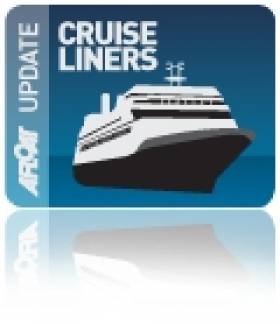Displaying items by tag: Grand Class Cruiseships
‘Grand’ Class Cruiseships to Dublin Port Raised the Bar Frequently Before Largest Ship Ever
#GrandClassCaller - Princess Cruises 'Grand' class Caribbean Princess of 112,894 tonnes docked in Dublin Port this morning as one of the largest ever ships to call and at a deck higher than the historic call next week of the mighty MSC Spendida set to break all records, writes Jehan Ashmore.
Despite the record-breaking visit next Monday of MSC Splendida 137,396 tonnes one should not easily dismiss today's call of the higher 19-deck Caribbean Princess with 3,142 passengers and 1,200 crew. Noting a sister, Ventura of P&O Cruises is understood to hold the current Dublin Port record at 116,017 tonnes as the largest ever ship of any type to visit the capital.
MSC Splendida is however the longest cruiseship at 333m long to visit Dublin Port. Due to the confines of quayside layout this is why the 3,247 passenger / 1,370 crew vessel is to enter stern first i.e. in 'reverse'. As currently Alexandra Basin's turning circle is too restricted to swing the vessel within port.
It was however more than a decade ago that the 100,000 tonnes milestone of any ship to enter Dublin Port was surpassed. The honour went to 'Grand' class leadship, Grand Princess of 108,806 tonnes to set that historic first in 2004. As for the sheer size of the ship, I vividly recall the scene as she glided past the Poolbeg Lighthouse under a brilliant welcoming blue sky over the port and city alike.
Then that record-breaking 'Grand' call was also particularly notable given that the owners of Princess Cruises, Miami based Carnival Corporation had a contract with Dublin Port Company to bring 26,000 passengers and 14,000 crew alone throughout the following year. At the time these cruise tourism figures were the equivalent to 10 normal cruises generating an estimated €23m to the capital's economy.
Also notable during the 'Grand's class inaugural call was the vessel's distinctive signature 'Skywalker's Nightclub'. Having boarded for a port visit, this structure seemingly perched precariously in a cradle suspended above the stern was at 18-decks high! On the 'Caribbean' this feature remains on deck 19, affording even more amazing views over the sea and port destinations visited.
Ironically, the structure of the Italian 1998 built Grand Princess was removed in recent years as previously reported on Afloat.ie. This was to improve efficiencies on operational fuel costs.
The Grand Princess current tonnage is still an impressive 107,517 and given that the class remain the most frequent and largest callers to the island for more than a decade, calling not just to Dublin Port but also Belfast and to Cork. Princess Cruises celebrates 50 years of service noting a sister brand, Cunard Line have their 175th anniversary also in 2015.
Next week's call to Dublin Port of MSC Splendida on Monday (11 May) will certainly elevate the position of the port status to accommodate much larger cruiseships given the proposed €30 cruise terminal at Alexandra Basin.
The proposed double-berth facility near the East-Link bridge would allow for even larger cruiseships to berth those been Royal Caribbean Lines 360m long mega 'Quantum' class with almost a 5,000 passenger capacity.
Add to the mix are Dun Laoghaire Harbour Company plans for a proposed €18m single cruise-berth.
MSC Splendida will make another Dublin Bay appearance albeit at anchorage off Dun Laoghaire Harbour on 21st May. Before she calls, the opening Dun Laoghaire season caller as previously reported will be Royal Princess (not 'Grand' class) on 12th May. Again this visit offshore is where tenders will cater for the 3,600 passenger capacity vessel of 141,000 tonnes completed in 2013 and which has a 1,346 crew.
Only the Port of Cork will be able to claim the ability to accommodate the Quantum class trio, when phase two of a €1.5m upgrade is completed later this year at Cobh.
As previously reported, Cobh expects to handle these massive cruiseships but not until 2017.





























































